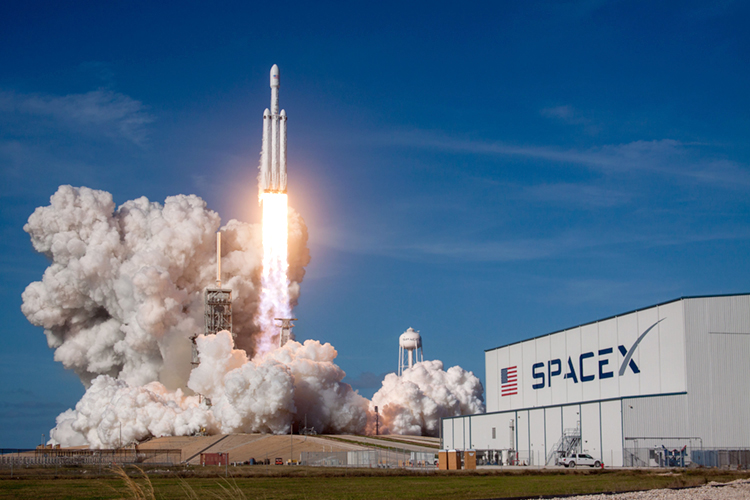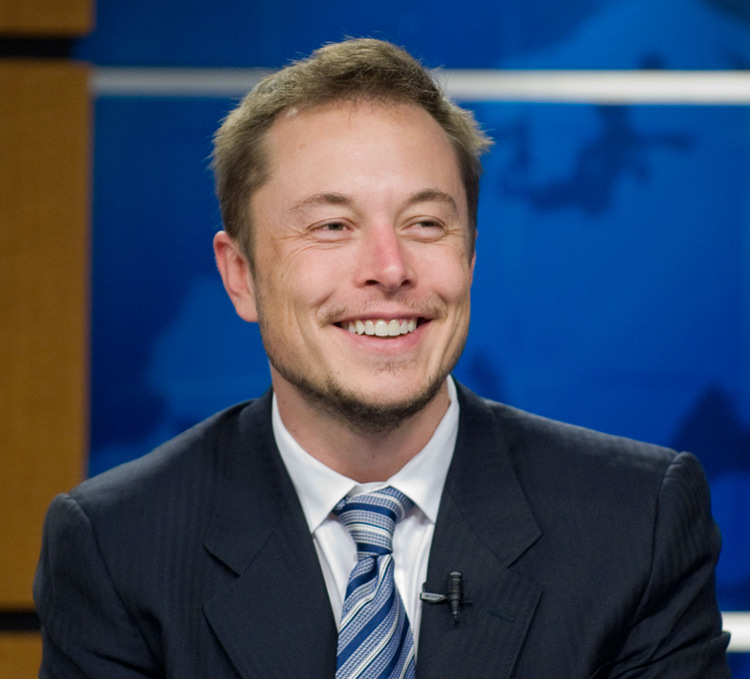Generation SpaceX
October 3, 2018
With reusable rockets, frequent launches, and a grand vision, SpaceX is changing the nature of spaceflight.
Space Exploration Technologies Corporation (commonly called SpaceX), a United States commercial rocket company, is on a roll. The company, founded and led by South Africa-born entrepreneur Elon Musk, has had a perfect launch record since the 2016 explosion of one of its rockets during a launch pad test. So far in 2018, SpaceX has executed stunning launches, made splashy announcements, and conducted important engineering upgrades to further its mission to make space more accessible.
Driving past Mars thanks to the Falcon Heavy
When most people want to get rid of an old car, they might trade it in for credit toward a new one, tow it to a junkyard, or donate it to charity. On February 6, Elon Musk took a different route with his old Tesla Roadster: launching it into space. Musk sent the car into an elliptical orbit around the sun, traveling as far out as the main asteroid belt. The whimsical cargo was, in fact, part of an important mission. It was the test payload for the first launch of SpaceX’s new rocket, called the Falcon Heavy. It was the most powerful rocket launch since those of the U.S. space shuttle program.
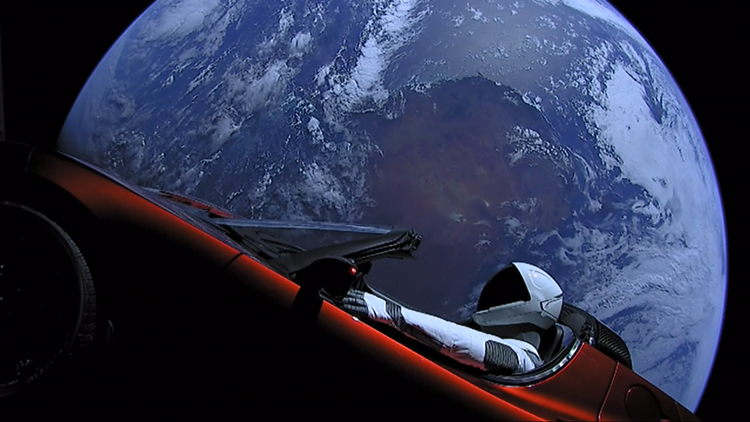
The Falcon Heavy launched into space a Tesla Roadster, seen here with Earth in the background, piloted by a dummy driver named “Starman.” Credit: SpaceX
The rocket used three modified boosters from SpaceX’s workhorse rocket, the Falcon 9. The two side boosters were “flight-proven” Falcon 9 boosters from previous missions, having landed back on Earth near the launch pad or on one of the company’s drone ships (uncrewed barges) at sea. After sending the central booster into the upper atmosphere, the side boosters returned to Earth in a spectacular tandem landing. The center booster attempted to land on a drone ship in the Atlantic Ocean, but not enough of the rocket engines fired during its descent. It slammed into the water a short distance away from the barge and was destroyed.
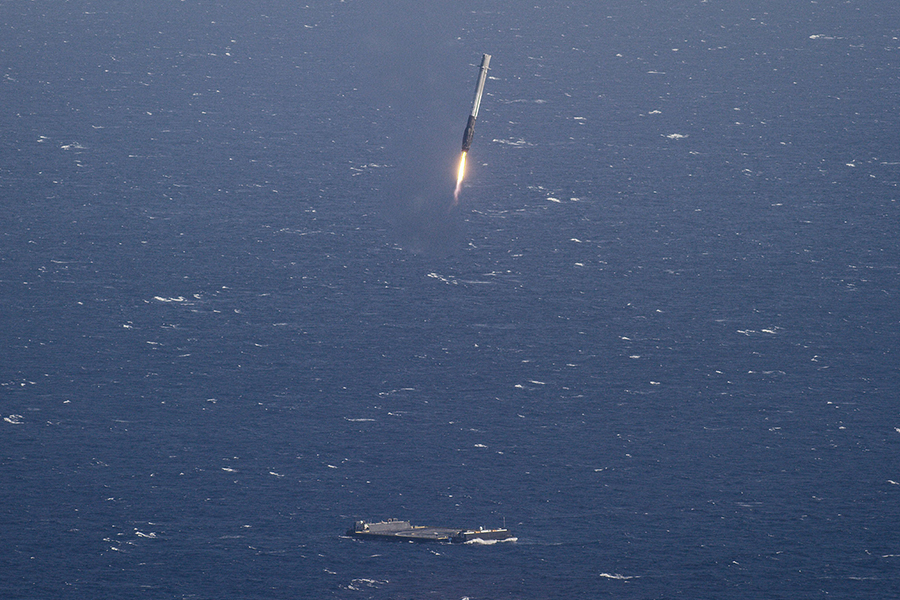
A Falcon 9 rocket prepares to land on a drone ship in the Atlantic Ocean on April 8, 2016. Credit: SpaceX
Reusable rocket
The failure of SpaceX to land the center booster of the Falcon Heavy was the first such failed attempt since June of 2016. Since the company’s first successful booster landing in 2015, it has become a common—albeit still spectacular—occurrence. The first stage boosters represent 60 percent of the cost of the rocket, so reusing a booster saves millions of dollars. The company plans to reuse more parts of spacecraft in the future. Several times, SpaceX has narrowly missed catching payload fairings (the clamshell-like halves of the rocket’s nose that fall back to Earth) using a boat equipped with a huge net.
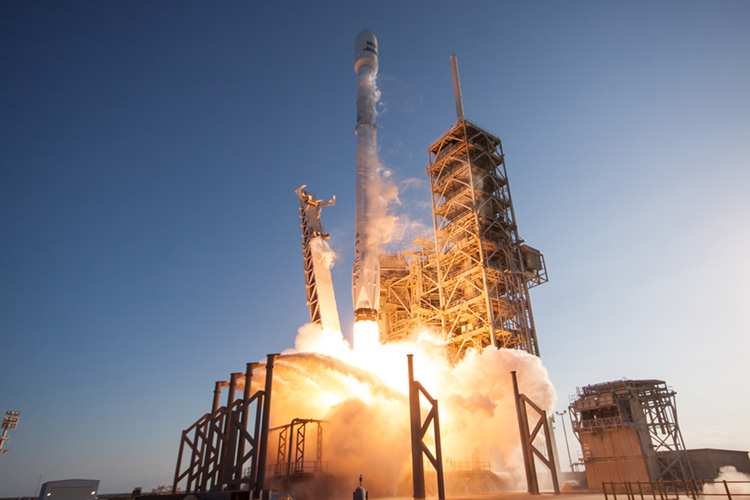
A recycled SpaceX Falcon 9 rocket launches from Florida’s Kennedy Space Center on March 30, 2017. Credit: SpaceX
SpaceX has succeeded in bringing launch costs down by repeatedly landing and reusing its boosters, something that no other company or space agency has been able to do (the U.S. space shuttle program featured partly reusable components, but they required extensive repair and refurbishment after each flight). In 2013, when SpaceX executed its first commercial space flights, the company’s launches represented less than 10 percent of space traffic that year. In the first three quarters of 2018, SpaceX has already flown 16 times—more than 60 percent of the current traffic market. Much of the company’s increase has come at the expense of Russia, whose state-operated space company, Roscosmos, has been marred by scandals and rocket malfunctions.

At Cape Canaveral Air Force Station in Florida, the SpaceX Falcon 9 rocket carrying NASA’s Transiting Exoplanet Survey Satellite (TESS) lifts off on April 18, 2018. Credit: SpaceX
SpaceX runs itself more like a technology startup than a traditional rocket manufacturer. In addition to saving money in the short term, landing the boosters has allowed SpaceX engineers to examine them and determine which pieces functioned well and which needed redesign, so the Falcon 9 is continuously retooled and upgraded. On May 11, SpaceX launched the first Block 5 version of the Falcon 9 in a mission to put a commercial satellite in orbit. The Block 5, which the company considers the final major upgrade of the rocket, is designed for multiple reuses. So far, Falcon 9 boosters have only flown twice before being discarded. The Block 5 should be able to fly up to 10 times without significant refurbishment and as many as 100 times in total. The Falcon 9 Block 5 flew a second time on August 7. The company hopes to eventually launch 60 Block 5′s per year after reuse is perfected.
Internet from space
In February, SpaceX put two satellites of their own into orbit. The two satellites, called Tintin A and Tintin B, were prototypes for a constellation meant to provide internet access from space. SpaceX calls this ambitious project Starlink. The company plans to launch some 4,500 Starlink satellites, almost equal to the total number of satellites (both working and defunct) orbiting Earth today. Starlink’s price tag will be at least $10 billion.
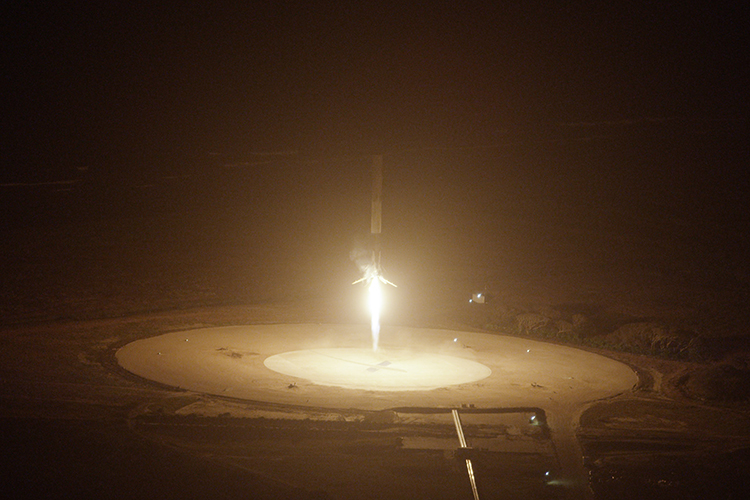
SpaceX’s Falcon 9 rocket lands at Cape Canaveral Air Force Station in Florida on Dec. 21, 2015. Credit: SpaceX
Satellite internet exists today, but it offers spotty, poor service. It is provided by a few large satellites in geostationary orbit (GSO), meaning they stay fixed in one place relative to the ground. Objects in GSO have to be far from Earth’s surface, making it hard to get a good connection. SpaceX plans to place Starlink satellites in low Earth orbit (LEO). So many satellites are needed because they will only be able to communicate with a small piece of Earth’s surface. On top of that, satellites in LEO are constantly moving relative to Earth’s surface. SpaceX will have to develop ways to transfer internet traffic from one satellite to another as they travel over locations on Earth.
If SpaceX can surmount these challenges, the payoff will be enormous. The connection quality from such a constellation would meet or exceed that from a traditional cable source. The connection would be just as strong on a desert island as it would be in the middle of a bustling city.
Too Heavy
SpaceX has two Falcon Heavy launches scheduled in 2019, including an important test for the U.S. Air Force. If successful, this test launch would pave the way for the Heavy to launch lucrative military satellites. But the Falcon Heavy will have a much smaller role in SpaceX’s fleet than was initially planned. Strapping three Falcon 9 boosters together has proven much more complicated than SpaceX engineers anticipated, causing a five-year delay in the Falcon Heavy’s first launch.
The Falcon Heavy is also losing out to single Falcon 9′s, as SpaceX’s process of continuous upgrades has made the rocket stronger and more durable. The Falcon 9 Block 5 is twice as powerful as the first Falcon 9, capable of lifting over 55,000 pounds (22,000 kilograms) to low Earth orbit. This capability satisfies most companies’ needs for about $30 million less than the price of a Falcon Heavy launch.
BFR: moon tourists and a Mars colony
SpaceX engineers are also designing and building a new booster called the Big Falcon Rocket, or BFR. The BFR would be far and away the largest rocket ever created. Musk plans for it to replace both the Falcon 9 and Falcon Heavy. It will be much larger, but Musk claims it will cost less than a Falcon 9 launch, which is already relatively cheap. One BFR could launch multiple large satellites at once. Companies could create new, super-sized satellites that were impossible to launch before.
Even more flashy than the BFR, however, is the giant spaceship Musk wants to launch with it. The Big Falcon Spaceship (BFS) would be the largest spacecraft ever launched. Its interior space would be roughly equal to that of the International Space Station (ISS), but the ISS was constructed over many years through dozens of launches. Huge windows would give BFS explorers panoramic views of space. Musk plans to use the BFS for his ultimate goal of colonizing Mars.
The National Aeronautics and Space Administration (NASA) is working on similar large boosters and space capsules, and with little commercial demand yet, SpaceX is exploring new options for financing BFR and BFS development. On September 17, the company announced that it had reached an agreement with Japanese billionaire Yusaku Maezawa to “rent” the first crewed flight around the moon in a BFS. Maezawa, an avid art collector, will be inviting artists of all kinds to share the experience. Although the terms of the deal were not made public, Musk stated that Maezawa’s payment was “a nontrivial amount that will have a material impact on the BFR program.” The flight around the moon could happen as early as 2023, though Musk, who is infamous for his aggressive timelines, admitted even this date was “aspirational.” But development is well under way. The company hopes to begin testing the BFS with suborbital flights in late 2019.
Whether or not the BFR flies, no one can accuse SpaceX or Elon Musk of thinking small. Indeed, many experts doubted the company would be able to build a reusable rocket, yet within a decade it created the cheapest and one of the most reliable rides to space available. Plans will continue to change, and time frames will continue to stretch, but all the while SpaceX will continue to reach for the stars.

